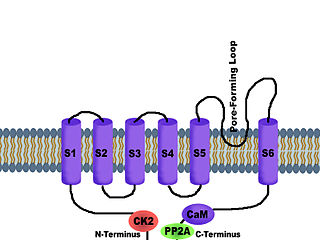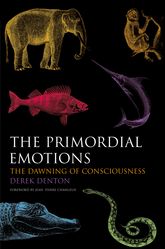Related Research Articles
In philosophy, rationalism is the epistemological view that "regards reason as the chief source and test of knowledge" or "any view appealing to reason as a source of knowledge or justification", often in contrast to other possible sources of knowledge such as faith, tradition, or sensory experience. More formally, rationalism is defined as a methodology or a theory "in which the criterion of truth is not sensory but intellectual and deductive".
Personality is any person's collection of interrelated behavioral, cognitive and emotional patterns that comprise a person’s unique adjustment to life. These interrelated patterns are relatively stable, but can change over long time periods.

The brainstem is the stalk-like part of the brain that interconnects the cerebrum and diencephalon with the spinal cord. In the human brain, the brainstem is composed of the midbrain, the pons, and the medulla oblongata. The midbrain is continuous with the thalamus of the diencephalon through the tentorial notch.

The midbrain or mesencephalon is the rostral-most portion of the brainstem connecting the diencephalon and cerebrum with the pons. It consists of the cerebral peduncles, tegmentum, and tectum.

Arousal is the physiological and psychological state of being awoken or of sense organs stimulated to a point of perception. It involves activation of the ascending reticular activating system (ARAS) in the brain, which mediates wakefulness, the autonomic nervous system, and the endocrine system, leading to increased heart rate and blood pressure and a condition of sensory alertness, desire, mobility, and reactivity.

The periaqueductal gray is a brain region that plays a critical role in autonomic function, motivated behavior and behavioural responses to threatening stimuli. PAG is also the primary control center for descending pain modulation. It has enkephalin-producing cells that suppress pain.

The reticular formation is a set of interconnected nuclei that are located in the brainstem, hypothalamus, and other regions. It is not anatomically well defined, because it includes neurons located in different parts of the brain. The neurons of the reticular formation make up a complex set of networks in the core of the brainstem that extend from the upper part of the midbrain to the lower part of the medulla oblongata. The reticular formation includes ascending pathways to the cortex in the ascending reticular activating system (ARAS) and descending pathways to the spinal cord via the reticulospinal tracts.

Parinaud's syndrome is a constellation of neurological signs indicating injury to the dorsal midbrain. More specifically, compression of the vertical gaze center at the rostral interstitial nucleus of medial longitudinal fasciculus (riMLF).
Reduced affect display, sometimes referred to as emotional blunting or emotional numbing, is a condition of reduced emotional reactivity in an individual. It manifests as a failure to express feelings either verbally or nonverbally, especially when talking about issues that would normally be expected to engage emotions. In this condition, expressive gestures are rare and there is little animation in facial expression or vocal inflection. Additionally, reduced affect can be symptomatic of autism, schizophrenia, depression, post-traumatic stress disorder, depersonalization derealization disorder, schizoid personality disorder or brain damage. It may also be a side effect of certain medications.

Sanal Edamaruku is an Indian author and rationalist. He is the founder-president and editor of Rationalist International, the president of the Indian Rationalist Association and the author of 25 books and other articles. In 2012, after examining an alleged miracle at a local church in Mumbai, he was charged under India's blasphemy law, causing him to voluntarily exile to Finland.

Narendra Nayak is a rationalist, sceptic, and godman debunker from Mangalore, Karnataka, India. Nayak is the current president of the Federation of Indian Rationalist Associations (FIRA). He founded the Dakshina Kannada Rationalist Association in 1976 and has been its secretary since then. He also founded an NGO called Aid Without Religion in July 2011. He tours the country conducting workshops to promote scientific temper and showing people how to debunk godmen and frauds. He has conducted over 2000 such demonstrations in India, including some in Australia, Greece, England, Norway, Denmark, Sri Lanka and Nepal. He is also a polyglot who speaks 9 languages fluently, which helps him when he is giving talks in various parts of the country.
Leabra stands for local, error-driven and associative, biologically realistic algorithm. It is a model of learning which is a balance between Hebbian and error-driven learning with other network-derived characteristics. This model is used to mathematically predict outcomes based on inputs and previous learning influences. This model is heavily influenced by and contributes to neural network designs and models. This algorithm is the default algorithm in emergent when making a new project, and is extensively used in various simulations.

SK channels are a subfamily of calcium-activated potassium channels. They are so called because of their small single channel conductance in the order of 10 pS. SK channels are a type of ion channel allowing potassium cations to cross the cell membrane and are activated (opened) by an increase in the concentration of intracellular calcium through N-type calcium channels. Their activation limits the firing frequency of action potentials and is important for regulating afterhyperpolarization in the neurons of the central nervous system as well as many other types of electrically excitable cells. This is accomplished through the hyperpolarizing leak of positively charged potassium ions along their concentration gradient into the extracellular space. This hyperpolarization causes the membrane potential to become more negative. SK channels are thought to be involved in synaptic plasticity and therefore play important roles in learning and memory.
James D. Fearon is the Theodore and Francis Geballe Professor of Political Science at Stanford University; he is known for his work on the theory of civil wars, international bargaining, war's inefficiency puzzle, audience costs, and ethnic constructivism. According to a 2011 survey of International Relations scholars, Fearon is among the most influential International Relations scholars of the last twenty years. His 1995 article "Rationalist Explanations for War" is the most assigned journal article in International Relations graduate training at U.S. universities.

Vasant Purushottam Sathe was an Indian politician of the Indian National Congress party. He was a lawyer by training and became a parliamentarian in 1972 and a cabinet minister during the 1980s. He was a socialist and came to prominence in the congress after Indira Gandhi split the party for a second time in 1978. He was also known for his tenure as Union Minister of Information and Broadcasting when he initiated the process which led to Indian television moving into colour broadcasting for the Asian Games 1982 and Hum Log the first colour Indian soap-opera.

Trace amine-associated receptor 2 (TAAR2), formerly known as G protein-coupled receptor 58 (GPR58), is a protein that in humans is encoded by the TAAR2 gene. TAAR2 is coexpressed with Gα proteins; however, as of February 2017, its signal transduction mechanisms have not been determined.

Pituitary homeobox 3 is a protein that in humans is encoded by the PITX3 gene.
Atheism and agnosticism have a long history in India and flourish within the Śramaṇa movement. Indian religions like Jainism, Hinduism and Buddhism consider atheism to be acceptable. Doubt has been ingrained even in Indian spiritual culture. India has produced some notable atheist politicians and social reformers. Around 0.7 million people in India did not state their religion in the 2001 census and were counted in the "religion not stated" category. They were 0.06% of India's population. Their number has significantly increased four times, from 0.7 million in the 2001 census to 2.9 million in the 2011 census at an average annual rate of 15%. According to the 2012 WIN-Gallup Global Index of Religion and Atheism report, 81% of Indians were religious, 13% were non-religious, 3% were convinced atheists, and 3% were unsure or did not respond, while a demographic study by Cambridge University Press in 2004 found that around 2-6% of Indians identified as atheists or irreligious.

The Primordial Emotions: The Dawning of Consciousness is a 2006 book by Australian neuroscientist Derek Denton.
The isthmic organizer, or isthmus organizer, also known as the midbrain−hindbrain boundary (MHB), is a secondary organizer region that develops at the junction of the midbrain and metencephalon. The MHB expresses signaling molecules that regulate the differentiation and patterning of the adjacent neuroepithelium. This allows for the development of the midbrain and hindbrain as well as the specification of neuronal subtypes in these regions. The fact that the MHB is sufficient for the development of the mid and hindbrain was shown in an experiment where quail MHB cells transplanted into the forebrain of a chick were able to induce an ectopic midbrain and cerebellum.
References
- ↑ "Debunking 'midbrain activation' of children". The Hindu. Retrieved 10 October 2018.
- ↑ "'You start questioning things – the most blatant, harmful things, that are evil'". Indian Express.